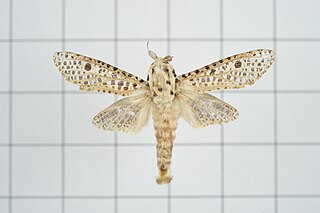Urodidae or "false burnet moths" is a family of insects in the lepidopteran order, representing its own superfamily, Urodoidea, with three genera, one of which, Wockia, occurs in Europe.
Agathiphaga is a genus of moths in the family Agathiphagidae, known as kauri moths. This caddis fly-like lineage of primitive moths was first reported by Lionel Jack Dumbleton in 1952, as a new genus of Micropterigidae.
Graphosia is a genus of moths in the family Erebidae.

Blepharoctenucha is a monotypic moth genus in the family Geometridae described by Warren in 1895. Its only species, Blepharoctenucha virescens, first described by Arthur Gardiner Butler in 1880, is known from India and Taiwan.
Buttia is a monotypic moth genus in the family Geometridae described by Warren in 1904. Its only species, Buttia noctuodes, was described by the same author in the same year.
Entogonia is a genus of moths in the family Geometridae described by Warren in 1904.
Hesperumia is a genus of moths in the family Geometridae. The genus was described by Packard in 1873.
Ithysia is a monotypic moth genus in the family Geometridae. Its only species is Ithysia pravata. The genus was erected by Jacob Hübner in 1825, but the species had been first described by Hübner in 1813.
Panagropsis is a monotypic moth genus in the family Geometridae described by Warren in 1894. Its only species, Panagropsis equitaria, described by Francis Walker in 1861, is found in South Africa.
Graphosia bilineata is a moth of the family Erebidae. It was described by George Hampson in 1900. It is found on New Guinea.
Graphosia phaeocraspis is a moth of the family Erebidae. It was described by George Thomas Bethune-Baker in 1908. It is found in New Guinea.
Graphosia polylophota is a moth of the family Erebidae. It was described by George Hampson in 1914. It is found on New Guinea. The small to medium-sized adults are often white, yellow, orange, or red with black markings on the forewings.
Graphosia lophopyga is a moth of the family Erebidae. It was described by Turner in 1940. It is found in Australia.
Graphosia ochracea is a moth of the family Erebidae. It was described by George Thomas Bethune-Baker in 1904. It is found in New Guinea. The habitat consists of mountainous areas.
Colabata marginalis is a moth in the family Bombycidae. It was described by Francis Walker in 1856. It is found in Brazil.
Ornarantia biferana is a moth in the family Choreutidae. It was described by Francis Walker in 1863. It is found in the West Indies and Brazil.
Macrobathra alternatella is a moth in the family Cosmopterigidae. It was described by Francis Walker in 1864. It is found in Australia, where it has been recorded from Queensland.
Morpheis pyracmon, the fissured bark, is a moth in the family Cossidae. It was described by Pieter Cramer in 1780. It is found in Suriname, Venezuela, Ecuador and Peru. The habitat consists of cloudforests, where it is found at altitudes between 400 and 1,200 meters.
Psychonoctua personalis is a moth in the family Cossidae. It was described by Augustus Radcliffe Grote in 1865. It is found on Cuba, Jamaica, Hispaniola and Puerto Rico.

Rapdalus pardicolor is a moth in the family Cossidae. It was described by Frederic Moore in 1879. It is found in Taiwan, India, Thailand and Laos.



